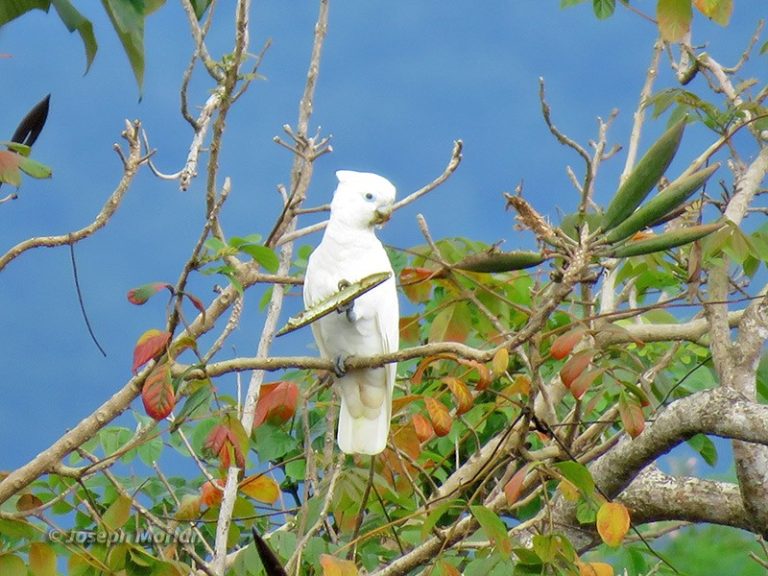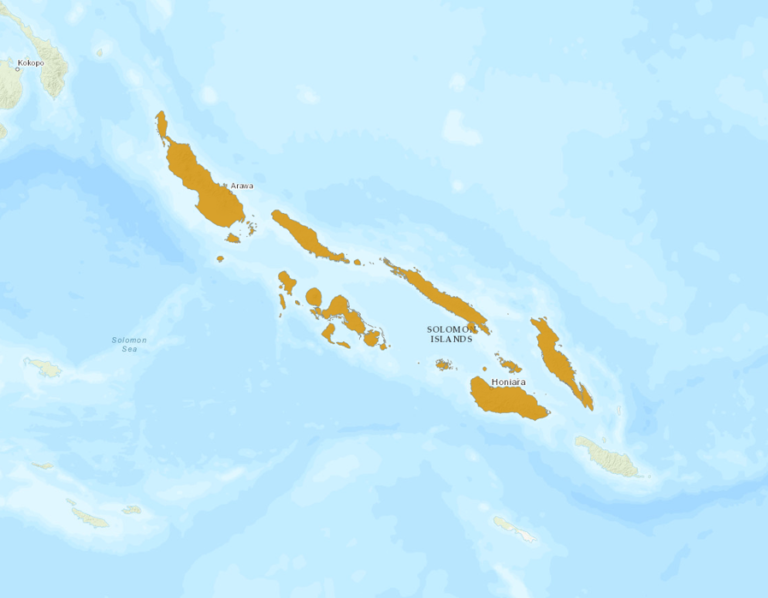Birdfinding.info ⇒ Generally common across most of its range. Unlike several closely related cockatoo species, its popularity as a cagebird does not appear to have resulted in any noticeable depletion of its natural populations nor any feral populations outside of the Solomon Islands.
Solomons Corella
Cacatua ducorpsii
Endemic to the Solomon Islands: Bougainville to Malaita and Guadalcanal, where it occurs in all types of wooded and semiopen habitats.

Solomons Corella—apparently an urban-adapted individual in the capital city of the Solomon Islands. (Honiara, Guadalcanal, Solomon Islands; May 8, 2010.) © Lee-Lien Wang
Identification
A small white cockatoo with bluish orbital skin and a pale ivory or horn-colored bill. The only cockatoo native to the Solomons, so rarely mistaken for any other species, though it is nearly identical to its sibling species, the Tanimbar Corella (see below for a more detailed comparison) of Indonesia’s Tanimbar Islands.

Solomons Corella with its crest raised. (Betikama, Guadalcanal, Solomon Islands; July 17, 2015.) © Lars Petersson
Most of the plumage appears either white or slightly dingy off-white. Sometimes shows a pinkish blush, most often on the face.
The orbital skin coloration varies, usually appearing pale-grayish at long range, tending toward bluish when seen closely.
It has a medium-sized crest that it usually keeps lowered. When raised, it extends to a peak about two or three inches above the forehead.
As in other white cockatoos, the undersides of the wings and tail are suffused with a yellowish wash.

Solomons Corella, showing blue orbital skin. (Tetepare, Solomon Islands; June 13, 2019.) © Devon DeRaad

Solomons Corella. (Tetepare, Solomon Islands; June 12, 2019.) © Isaac Rush
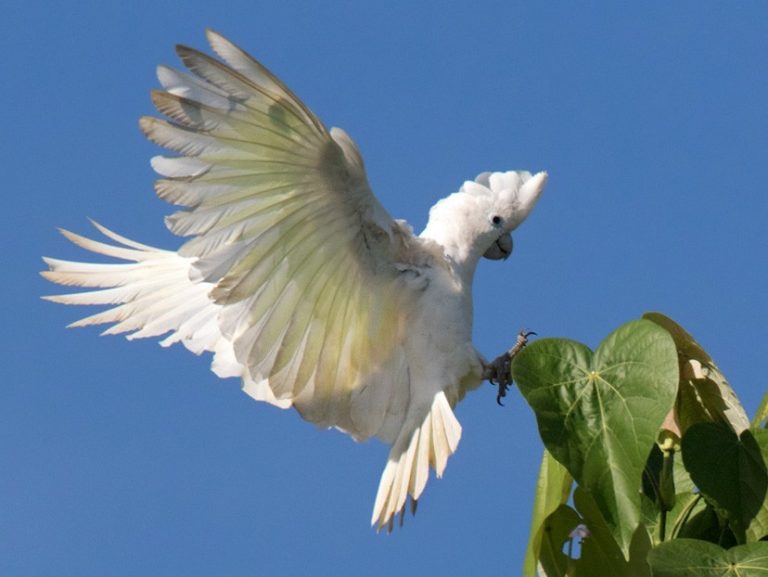
Solomons Corella, showing pale yellowish wash on the underwings. (Mount Austin, Queen Elizabeth National Park, Guadalcanal, Solomon Islands; July 23, 2015.) © Lars Petersson
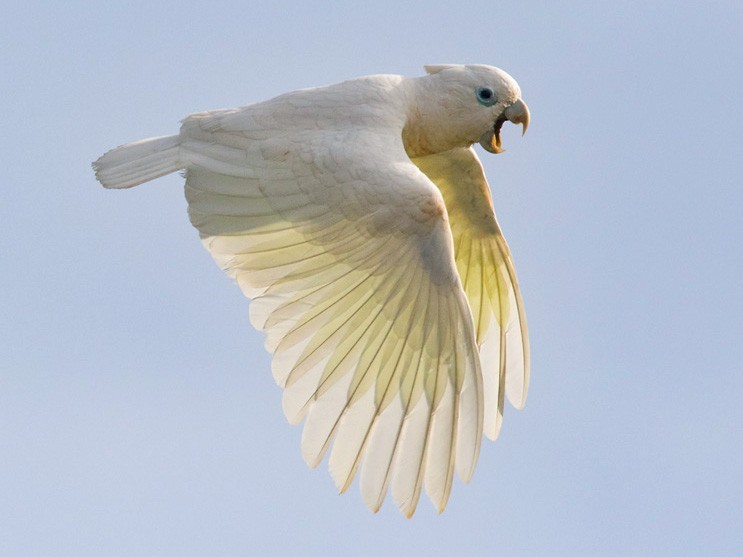
Solomons Corella, showing blue orbital skin and yellowish wash on the wings. (Betikama, Guadalcanal, Solomon Islands; July 17, 2015.) © Lars Petersson

Solomons Corella, dorsal view in flight, showing all-white upperparts. (Betikama, Guadalcanal, Solomon Islands; July 17, 2015.) © Lars Petersson
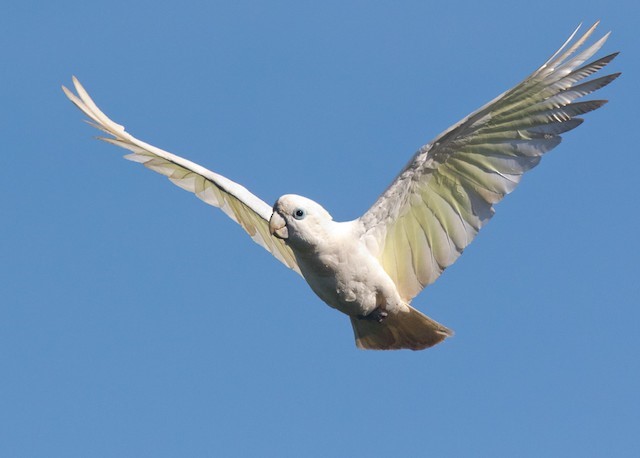
Solomons Corella, showing pale yellowish wash on the underwings. (Mount Austin, Queen Elizabeth National Park, Guadalcanal, Solomon Islands; July 23, 2015.) © Lars Petersson
Notes
Monotypic species. Also known as Ducorps’s Corella or Ducorps’s Cockatoo—especially in aviculture.
See below for comparisons of Solomons Corella with Tanimbar Corella and White Cockatoo.
Cf. Tanimbar Corella. Tanimbar and Solomons Corellas are closely-related, nearly-identical sibling species that do not occur together naturally, but as escaped cagebirds might overlap almost anywhere. They are almost exactly the same size, shape, and colors—with mostly whitish plumage, a yellowish wash on the underwings and undertail, and pale, ivory or horn-colored bills. The visual differences between them are slight and difficult to ascertain.
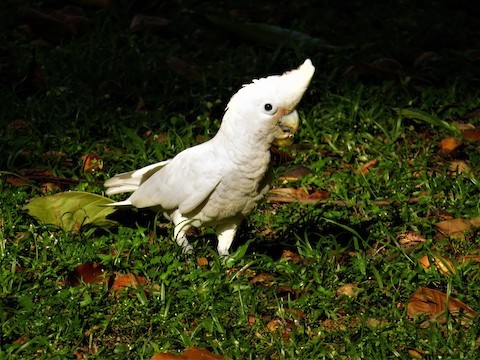
Tanimbar Corella showing big-eyed impression and pink in the lores. (Changi Point, Singapore; February 22, 2020.) © Evelyn Lee

Solomons Corella, showing pale bluish “goggle-eyed” impression and a pinkish flush on the face. (Tetepare, Solomon Islands; June 16, 2019.) © Devon DeRaad
Orbital Skin Color: Tanimbar Corella has white orbital skin, whereas Solomons’ tends to be either grayish or bluish. The difference in shading between white and grayish is slight, but the difference in overall appearance is fairly consistent. On Tanimbar, the white orbital skin gives the appearance of unnaturally big eyes, like a child’s toy. On Solomons, the grayish orbital skin gives the appearance of goggles around normal-sized eyes.
Lore Coloration: Tanimbar Corella usually has pinkish feathers beside the base of the bill, most pronounced around the lores. Solomons generally lacks this feature—its lores are whitish, matching the rest of its plumage.
Vocalizations: The typical calls of Tanimbar and Solomons Corellas seem to differ. Tanimbar tends to give harsh, screechy, monosyllabic calls. Tanimbar appears to have a more diverse repertoire, across a wider range of pitches, some harsh and some not, often repeating brief phrases.
Cf. White Cockatoo. White Cockatoo and Solomons Corella are both essentially all-white cockatoos. They do not occur together naturally, but as popular cagebirds both could occur nearly anywhere. White Cockatoo is somewhat larger, with a longer crest (but short on some immatures) and white orbital skin—whereas Solomons’ is grayish or bluish. The most consistent diagnostic difference is bill color: black on White Cockatoo and ivory or horn-colored on Solomons Corella.
Additional Photos of Solomons Corella

Solomons Corella, showing pale bluish “goggle-eyed” appearance. (Tetepare, Solomon Islands; June 12, 2019.) © Isaac Rush

Solomons Corella. (Tetepare, Solomon Islands; June 16, 2019.) © Devon DeRaad
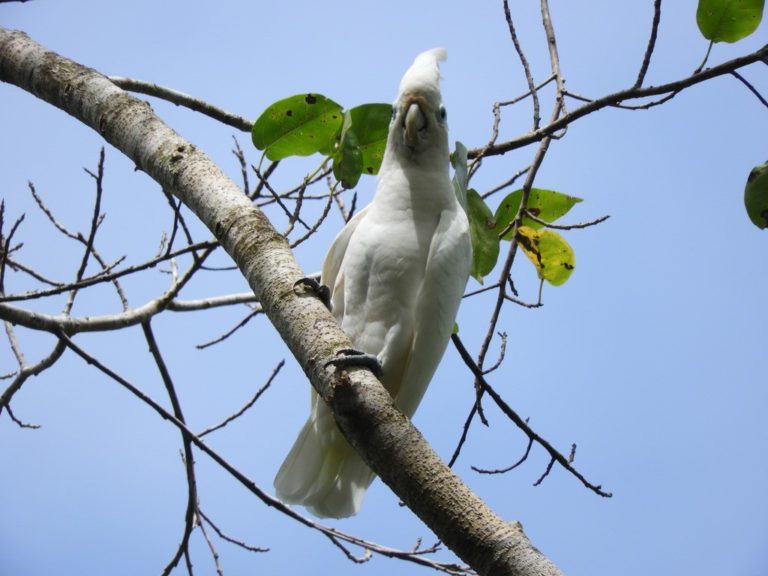
Solomons Corella. (Tetepare, Solomon Islands; June 12, 2019.) © Isaac Rush

Solomons Corella. (Betikama, Guadalcanal, Solomon Islands; July 17, 2015.) © Lars Petersson
References
BirdLife International. 2018. Cacatua ducorpsii. The IUCN Red List of Threatened Species 2018: e.T22684823A130100557. https://dx.doi.org/10.2305/IUCN.UK.2018-2.RLTS.T22684823A130100557.en. (Accessed September 8, 2021.)
Cameron, M. 2007. Cockatoos. CSIRO Publishing, Collingwood, Victoria, Australia.
eBird. 2020. eBird: An online database of bird distribution and abundance. Cornell Lab of Ornithology, Ithaca, N.Y. http://www.ebird.org. (Accessed September 8, 2021.)
Forshaw, J.M. 2010. Parrots of the World. Princeton University Press.
Juniper, T., and M. Parr. 1998. Parrots: A Guide to Parrots of the World. Yale University Press.
Michigan State University. 2020. AVoCet: Avian Vocalizations Center. https://avocet.integrativebiology.natsci.msu.edu/. (Accessed September 8, 2021.)
Mulawki, E.J. 2014. The Cockatoos: A Complete Guide to the 21 Species. McFarland Publishing, Jefferson, N.C.
Xeno-Canto. 2021. Solomons Cockatoo – Cacatua ducorpsii. https://www.xeno-canto.org/species/Cacatua-ducorpsii. (Accessed September 8, 2021.)
